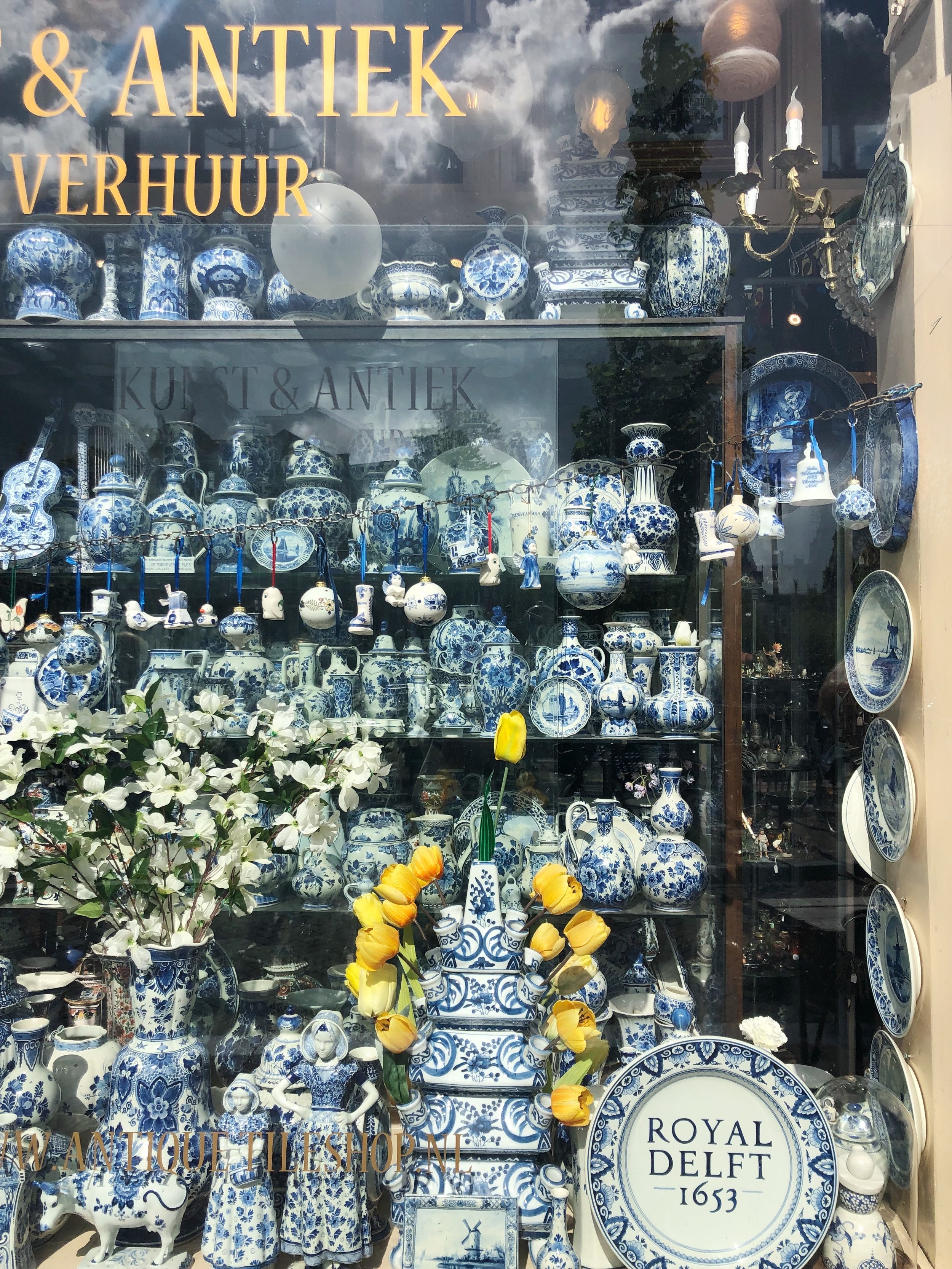When I travel to a new city, I like to be surprised by what catches my eye. If it holds my attention long enough, I investigate why. My first day in Amsterdam, I was greeted with intricately patterned tiles lining the entryway of our Airbnb.
It was the first thing I noticed between the gorgeous blooming wisteria hanging off the crooked canal houses and the impressive bike piles lining the narrow cobbled road.
Most likely when you picture Dutch tile design, you imagine Delftware or Delft Blue; a type of tin-glazed earthenware. The truth is this iconic blue and white pottery originated in China. It gained popularity with the Dutch in the 16th century due to Chinese imports.
Chinese porcelain was a coveted commodity and a status symbol of wealth. So naturally, the Dutch wanted to create their own version. Although there are currently less tile factories in Holland than there once were during the thriving Golden Age of the 17th century; Dutch tiles are still manufactured and collected today.
Kramer Kunst & Antiek, (pictured above) is a large antique tile store with abundant collections available for purchase.
If you take the (free) ferry to Amsterdam Noord, you will walk through Cuyperspassage; the 110 meter tunnel made of approximately 80,000 Delft Blue Dutch tiles. Designed by graphic designer, Irma Boom, these tiles depict naval history and inspiration from Rotterdam tile painter, Cornelius Boumeester’s original tile design of the Warship Rotterdam.
The making of the tile tableau took Royal Tichelaar Makkum, a cermaic company, five years to manufacture. Which makes sense when you realize that the traditional size of a Dutch ceramic tile is only 13 x 13 cm.
Examples of Delftware found in the neighborhoods of Amsterdam & the Rijksmuseum’s collection
Despite many attempts, The Dutch were not able to recreate the same composition of Chinese porcelain. One reason was due to differences in the type of clay. Chinese blue and white pottery is made from a white clay called kaolin, which when baked at high temperatures, creates their famous porcelain. The Dutch “porcelain” is a low-fire earthenware, made from a yellow or brownish clay that is coated with a tin glaze after it is fired.
Examples of different types of Dutch tile imagery
Imagery depicted on Dutch tiles ranges from florals (specifically tulips), pastoral scenes, seascapes, Jugendstil or Art Nouveau motifs, as well as animals, mythological scenes, warriors and knights to name a few.
The use of shapes such as circles or diamonds as central frames are popular reoccurring tile designs. Corner ornaments also have specific names for their motifs, from the iconic fleur-de-lis to lesser known names such as the sinister sounding “spider nine-dot.”
Diagram found in “Tile Tales, All you need to know about Dutch Tiles,” by Frans Klein
A great way to get a closer look at Dutch tiles without awkwardly standing in a stranger’s entryway and having to try to explain your suspicious appearance (this almost happened to me on more than once occasion) is to visit the Rijksmuseum. Currently on display, along with stunning works by Rembrandt, is the exhibition, “Treasures from Storage Tiles.”
“Tiles both protect and decorate. Their glazed surface makes them durable and easy to clean. In the 17th and 18th centuries tiles were therefore used chiefly on plinths, in kitchens and around the hearth.
Motifs were often repeated, giving rise to larger patterns and sometimes even depictions spread over multiple tiles. While tiles are frequently associated with Delft, the leading centers of production were actually in Rotterdam, Utrecht, and the province of Friesland.”
- excerpt from Treasures From Storage
A portion of Rijksmuseum’s Dutch Tile Collection
You can even find evidence of tiles used in domestic settings in the famous painting, “The Milkmaid,” (created in 1657-58) by Dutch painter, Johannes Vermeer, also on view at the Rijksmuseum.
I simultaneously found Delftware references emerging within the contemporary works of (new to me artists) Lawrence James Bailey and Cosima Von Bonin.
Lawrence James Bailey, “Black Holes in the Dutch Countryside” (2019), glazed ceramic tiles (each 13x13x.08cm)
Bailey’s Dutch tiles are currently on view as part of a two person exhibition centered on the theme of landscapes. The show titled Around The Corner at Galerie Bart, is also coincidentally how I happened to discover this work. It was my happenstance of picking the right corner to turn around.
Playing with the history of landscape imagery within Delftware, Bailey describes this space, in his own words:
“The border area where the city and the surrounding landscape meet. A kind of no man’s land where hardly anybody goes and where criminal activities take place…You won’t get eaten up by a wolf, but it can be dangerous there just the same and end up in confrontations.” - Lawrence James Bailey
Cosima Von Bonin, “Markus and Blinky,” (2000), lead, cotton, cloth, adhesive tape
On the other hand, I specifically sought out the exhibition, Hybrid Sculpture, on view at the Stedelijk Museum, and unexpectedly found Von Bonin’s textile work.
Cosima Von Bonin detail
Von Bonin’s references to Delftware iconography are present regardless of the absence of any ceramic medium. The piece, “Markus and Blinky,” (2000) is labeled by the Stedelijk Museum for working within a “complex network of appropriated forms and cultural codes.” Von Bonin uses the line of fine blue thread against a soft white cotton to illustrate the quintessential Dutch stereotype.
Souvenirs
My search for tiles and the tales they tell followed me even when I wasn’t looking for it. They told me stories of cultural heritage, architecture, art history and an even deeper love of blue and white.















